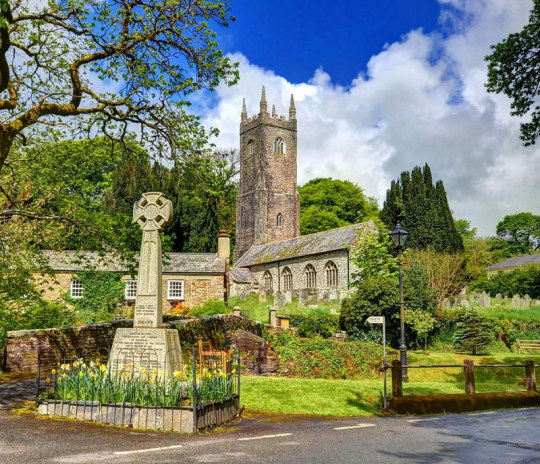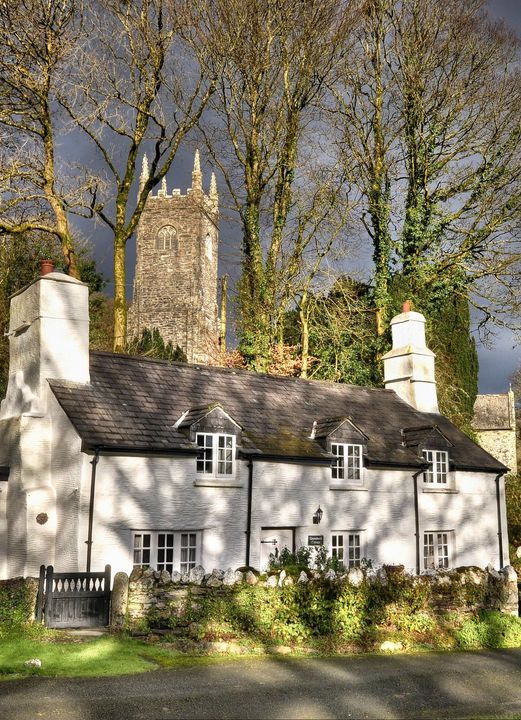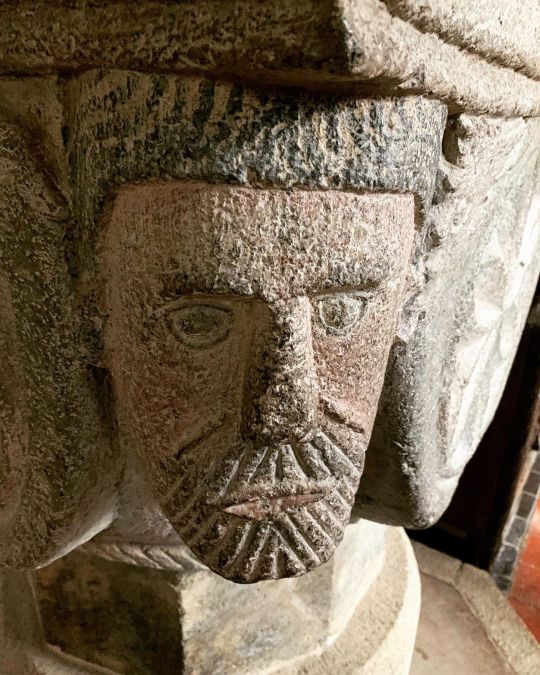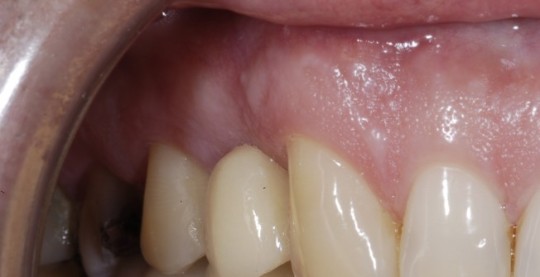#Altarnun
Text

Altarnun is one of those Cornish villages too timeless to be real
#Altarnun#Cornwall#English villages#Church of St Nonna#UK#parish church#village cross#timeless#rural britain
241 notes
·
View notes
Text

Altarnun, Cornwall, England
Early 1960s
0 notes
Text

The pews in St Nonna, Altarnun.
6 notes
·
View notes
Photo

The village of Altarnun, Bodmin Moor, Cornwall by Baz Richardson (away until 10 July) Altarnun must be one of the prettiest rural villages in the whole of Cornwall. A Norman church was built here in the 12th century, but the present church was built on the same site in the 15th century from unquarried stone from Bodmin Moor. The church is dedicated to St Nonna, mother of St David, who lived in the sixth century. A Celtic cross from the time of St Nonna is located by the church gate. As the largest parish church on Bodmin Moor, the Grade I-listed church is known as the Cathedral of the Moor. It is thought that construction of the tower may have commenced in the late 1300s, but most of the current church was built largely in the next century in the Perpendicular style, with its bell tower standing 109 ft high. Simon Jenkins considers this to be one of England's Thousand Best Churches. The stream which flows through Altarnun is known as Penpont Water and eventually joins the River Tamar. The narrow little medieval pack horse bridge (on the left) dates from the 15th century. The cottages beyond the bridge are both Grade II-listed and are thought to date from the late 1600s. https://flic.kr/p/2nsY418
1 note
·
View note
Photo

Footpaths and ferns... . . . #altarnun #cornwall #woodlandwalking #publicfootpath #stonestile #rambling #ferns #inthecountry (at Altarnun, Cornwall) https://www.instagram.com/p/CGMyoxsH2v3/?igshid=6vnumyow7d8v
0 notes
Photo

"Beneath a Steel Sky" at the Nine Stones stone circle on Bodmin Moor, watching the rain sweep past on both sides but not catching us. #ninestones #ninestonescircle #ninestonesstonecircle #bodminmoor #altarnun #beneathasteelsky #90sgamesreference #stonecircle #archaeology #historyiseverywhere (at Nine Stones, Altarnun) https://www.instagram.com/p/CDZehXgAAaC/?igshid=1sh4nvp4clsxp
#ninestones#ninestonescircle#ninestonesstonecircle#bodminmoor#altarnun#beneathasteelsky#90sgamesreference#stonecircle#archaeology#historyiseverywhere
0 notes
Photo

The Church of St Nonna, Altarnun, Cornwall
48 notes
·
View notes
Text

The beautiful little village of Altarnun, Bodmin Moor, Cornwall.
Cornwall's nooks, crannies, and narrow streets: BritainAndBritishness.com/CornwallsNarrowStreets
Baz Richardson.
Cottages and Villages
8 notes
·
View notes
Link
The depiction of albinism in popular culture, especially the portrayal of people with albinism in film and fiction, has been asserted by albinism organizations and others to be largely negative and has raised concerns that it reinforces, or even engenders, societal prejudice and discrimination against such people.[1] This trend is sometimes referred to as the "evil albino" plot device.[1]
The "evil albino" stereotype or stock character is a villain in fiction who is depicted as being albinistic (or displaying physical traits usually associated with albinism, even if the term is not used), with the specific and obvious purpose of distinguishing the villain in question from the heroes by means of appearance.[1][2] Traits of albinism commonly associated with the evil albino stereotype include pale skin, platinum blonde hair, and blue or pink-to-red eyes. Notably absent from most depictions is impaired vision, which is experienced by most real people with albinism.[1][3][4]
The stereotype has become sufficiently well-recognized to attract satire and to be considered a cliché. In response to the "albino gunmen" characters in The Da Vinci Code and The Matrix Reloaded, albinistic actor Dennis Hurley wrote, produced and starred in a short film parody, The Albino Code, playing up the stereotypes, illustrating a typical example of real-world prejudice, and pointing out that the vision problems associated with albinism would make a successful career as a hitman highly improbable. In The Big Over Easy, author Jasper Fforde includes an "albino community" protest against albino bias among his fictional news clippings, most of which satirize stock characters and hackneyed plot devices. Chicago Tribune movie reviewer Mark Caro says of this character type that it is someone "who looks albino and thus, in movie shorthand, must be vicious".[5] The National Organization for Albinism and Hypopigmentation (NOAH) has stated that there were a total of sixty-eight films from 1960 to 2006 featuring an "evil albino".[6]
Conversely, a number of real people with albinism have risen to fame (see § Notable people with albinism, below, especially in popular music and fashion modeling (though, as in the case of the Winter brothers, may themselves be the subject of "evil albino" parody). Albino animals capture public imagination and wonder as zoo attractions, and even in the wild can attract popular, positive attention (see § Notable albino animals, below.
History of the "evil albino" stereotype
The "evil albino" stereotype may also have its roots in Neolithic Eastern Europe, where some cultures depicted Death as a pallid woman with light hair.[7] Fear of vampires and other legendary undead with a deathly pallor, especially in European folklore, could also have contributed to albino bias. The phenomenon may also have been influenced by attitudes towards people with albinism in Africa or Jamaica, where those with that condition are sometimes regarded as cursed or magical (see § Folklore, urban legends and myths, below). Dermatologist Dr. Vail Reese theorizes that albino bias may be part of a broader Hollywood pattern of equating or at least linking skin disorders and appearance problems with villainy.[8]
Another explanation may be sought in respective ideals of ugliness — most "evil albinos" appear in works of fiction from the West. In fiction from Japan, where ideals call for as pale skin as possible, characters with albinism or associated traits are more frequently sympathetic[9] than in American and British fiction.[10] This is not to say that Japanese popular culture has not depicted "evil albinos". However, such characters in Japanese fiction are often bishōnen or bishōjo whose beautiful appearance gives contrast to their evil character. Use of albinistic features to indicate villains in Hollywood films appears to have begun in the 1960s, and may be related to the popularity of tanning (and thus a decrease in pale skin being seen as attractive) in this period.[2]
One of the oldest perceived literary examples of albino bias was H. G. Wells's depiction of the main character in his 1897 science-fiction novel The Invisible Man, who was able to become invisible using his scientific discoveries only because he already lacked natural pigmentation; aberrant even before his experimentation, he subsequently became completely deranged.
Albino bias is also alleged in modern times. For example, the 2003 Warner Bros movie The Matrix Reloaded featured two sociopathic characters with pale skin and white hair frequently interpreted to be albinos despite studio declarations that they are not.[4] Positive depictions of albinos in mass culture are rarer, though one example is the 1995 film Powder which depicts an exceptionally gifted albinistic youth and the cruelty he endures from "normal" people because of his differences. In recent years, the National Organization for Albinism and Hypopigmentation (NOAH) has spoken out[1] against albino bias in the United States. Albinistic actor Michael C. Bowman, of Me, Myself and Irene, has said, "Kids all over this country are being affected in a very negative and harmful way because of the sloppiness and laziness of a writer in Hollywood."[4]
Albinism and fiction
Note: These lists do not include characters whose appearance is reminiscent of albininism, but for reasons other than actual albinism. These include but are not limited to aliens, the undead, magical beings, unusually-colored anime/manga characters, etc. An exception is characters commonly perceived to be albinistic.
A number of movies, books and other works have been criticized[1][2][3] for albino bias, as they associate the uncommon features of albinistic people (pale skin, white hair, and unpigmented eyes) with danger, terror, or criminality. Less frequently they are depicted as the harmless butt of jokes and ridicule, as maladjusted and undersocialized, or as "freaks".[2][11] They may also actually be portrayed positively, even heroically – a more recent counter-trend.[citation needed] In the 2012 Canadian movie war witch (rebelle) by Kim Nguyen, telling the story of a runaway child soldier in West Africa and an albino boy played by Serge Kanyinda, albinos play an important role. The movie portrays an albino community.
Negatively portrayed characters
The most common depiction of people with albinism in fiction is that of the inimical, violent villain, especially the hitman, assassin, sociopath or crime boss.[2][3][4][11]
"The Family", a cult of plague survivors are the antagonist in the film The Omega Man (1971).
Silas, in the book The Da Vinci Code (2003) by Dan Brown, (played by Paul Bettany in the 2006 film adaptation), is described as being albinistic. He is a religious fanatic and an assassin who murders several people, although he repents at the end of the book, praying to God for mercy and forgiveness. Critics have called the portrayal "damning", "hateful", and "cruelly stereotypical".[12] In defense, author Brown has pointed out that "Silas's skin color has nothing to do with his violent nature – he is driven to violence by others' cruelty... not by anything inherent in his physiology" and that he believes "the novel's portrayal of Silas is a compassionate exploration of how difficult albinism can be – especially for young people – and how cruelly societies can ostracize those of us who look different", going on to say he considers Silas to be the most sympathetic character in the story.[13]
"The Twins" (played by Adrian and Neil Rayment), in The Matrix Reloaded (2003)[14] are considered by detractors[3] to be the highest-profile case of "evil albino" bias to date, though said by producers[4] to not be intended to be taken as actually albinistic.
Edgar and Johnny Autumn, in four 1995 issues of the Jonah Hex comic book, are mutant villain brothers for the main character to fight. They were thinly-disguised caricatures of real-life albinistic musician brothers, Edgar and Johnny Winter (see image, right), who filed an unsuccessful lawsuit (Edgar Winter et al. v. DC Comics et al.).[15] A spokesperson for Johnny Winter characterized the depiction as "picking fun at them for being albinos", while a DC Comics representative claimed that the characters were an homage.[16]
Griffin, the main character of The Invisible Man (1897) by H. G. Wells is of questionable sanity and a thief by nature, obsessed with colour and pigmentation due to his albinism. The text of Wells's novel implies that Griffin's invisibility formula works on him (and a white cat in an early experiment) only because of albinism. (See main article for sources.)
Francis Davey, the vicar of Altarnun in Daphne du Maurier's novel "Jamaica Inn" is an albino whose status as a 'freak of nature' is explicitly linked to his rejection of conventional morality and hence his villainous actions including murder.
Samuel Aboah from The X-Files episode "Teliko". He was a Burkinabé immigrant who, lacking a pituitary gland, harvested them from other African or African-American men to restore his skin tone. He is compared unfavourably to a vampire like creature from West African folklore (the eponymous Teliko) by a Burkinabé ambassador. He is depicted as a merciless killer with a seemingly inhuman ability to squeeze into small spaces (a la previous X-Files villain Eugene Victor Tooms)
"Snow" (played by Billy Drago), in Vamp (1986)[17] is the violently-inclined leader of a street gang composed of albinistic people and others with appearance problems. He meets a violent end.[2]
Joseph (played by Jake Busey, son of Gary Busey; see next entry), in Contact (1997)[18] is a religious extremist turned suicide-bomber.[4]
Mr. Joshua (played by Gary Busey), in Lethal Weapon (1987)[19] is a seemingly psychopathic hit man.[2] He was specifically referred to as "albino" in the film.
Bosie (played by Charlie Hunnam),[20] in Cold Mountain (2003)[21] is a U.S. Civil War-era "sneering albino killer ...[who] seems to have wandered in from a Lethal Weapon movie" — Ty Burr, Boston Globe review.[2][22]
"Bad Bob" (played by Stacy Keach) in The Life and Times of Judge Roy Bean (1972)
"Dragon" (played by Thayer David) in The Eiger Sanction (1975)[23] is an underworld kingpin also described as being unable to stand light and requiring frequent blood transfusions.
"The Albino" (played by Mel Smith), in The Princess Bride (1987)[24] is an Igor-like henchman and torturer, depicted as diseased, with visible sores.[2]
"Albino" (played by the genuinely albinistic Victor Varnado), in End of Days (1999)[25] is a menacing "servant of Satan" who meets a grisly death.[2]
"Whitey" Jackson a.k.a. "The Albino" (played by William Frankfather), in Foul Play (1978)[26] is another heavily armed killer, this time in a comedy.[2]
"Tombstone", in the Spider-Man comics is an African-American with albinism. He is a mob hitman. (See main article for sources.)
"Tobias Whale" a DC Comics African-American albinistic mobster whose villainy induces character Jefferson Pierce to become the superhero "Black Lightning". (See main article for sources.)
Moke (played by Dar Robinson), in Stick (1985)[27] is a ruthless criminal, who likes to shoot people in the back[2][4]
Judge Holden, in Cormac McCarthy's Blood Meridian (published 1985; ISBN 0-394-54482-X). In McCarthy's novel, Holden is a wanton mass-murderer. There is no historical evidence to suggest that the non-fictional Holden was albinistic. (See main article for further sources.)
"Albino" (played by Warrick Grier), in Freefall (1994)[28] is a menacing figure who drugs the film's heroine.[2]
Mark Purayah (Mark II) and Mark Parchezzi (Mark III) ("the Albinos"), in Hitman: Blood Money (released 2005)[29] are clones of an unseen Mark I, and all are assassins. (See main article for further sources.)
Otis B. Driftwood (played by Bill Moseley), in House of 1000 Corpses (2003).[30] leads a clan of psychopathic backwoods serial killers. Despite being played by the same actor, in the sequel The Devil's Rejects (2005)[31] he has a normal skin tone. (See main article for further sources.)
"The Albino" in The Albino's Dancer, a "Time Hunter" novella; the character is a mobster.(See main article for sources.)
"The Albino" (played by Bill Bolender) from the Star Trek: Deep Space Nine episode "Blood Oath", who is a dishonorable Klingon warrior and murderer. (See main article for further sources.)
Dr. Robert Kirkland "Kirk" Langström, also known as the Man-Bat, is depicted as being albinistic in the television series The Batman (which also depicts him as more villainous than other versions of the character).[32] Langström's "Man-Bat" form is also depicted as being albino.(See main article for further sources.)
Kobra, an albinistic biker in Robert R. McCammon's 1981 novel They Thirst who is depicted as sadistic and violent. He eventually becomes a commander of an army of vampires besieging Los Angeles (but was albinistic before becoming a vampire).(See main article for sources.)
Monsieur Zenith, a pulp fiction villain in the "Sexton Blake" series by Anthony Skene. Zenith is a world-weary gentleman thief who uses opium, commits crimes, and feuds with Blake simply to relieve his ennui.
The clairvoyant albino Juni Swan in Darren Shan's "The Demonata" series is characterized by her deceptive and sadistic nature as well as her exceptional beauty. However, in Death's Shadow, the seventh book of the series, she appears as a hideously deformed monster.
"Helter Skelter", a mysterious assassin seen in the opening cutscene of the video game No More Heroes
Bigboy, the sadistic, ruthless chief of the prison guards in the Stephen Hunter novel Pale Horse Coming.
Jei Farfarello, a sadistic/masochistic member of a group of assassins named "Schwarz" in the anime Weiß Kreuz. He is portrayed as a one-eyed, heavily scarred and clinically insane killer.
Olivia Presteign, the daughter of a powerful business man in Alfred Bester's The Stars My Destination, is responsible for numerous homicides along with various other crimes. Her albinism renders her blind to the normal spectrum of light visible to humans, but she is able to see the infrared spectrum.
The anime/manga Deadman Wonderland features two albinos named Chan and En as bodyguards to the main antagonist of the series, the director of Deadman Wonderland named Hagire Rinichirou. They are twin brother and sister, and are incredibly loyal to Hagire, seeing him as a father figure and killing people who merely insult him. There is also a third albino, one of the main characters, named Shiro, who appears an innocent and complacent young girl, but has a cruel and psychopathic alter ego knows as the Wretched Egg, which is Hagire's lifetime obsession.
The Mark clones in Hitman: Blood Money are genetically-created assassins from the rival organization The Foundation.
Shadow Prove from Bakugan New Vestroia is most probably albino. He often laughs at other peoples problems and tries to annoy but hates being insulted by Mylene, his companion. He is part of the evil organisation Vexos.
Animals and other non-humanoid characters
In Ice Age: Dawn of the Dinosaurs, the main antagonist, named Rudy, is a huge albino Baryonyx. Unlike most other dinosaurs in the film, he is depicted as vicious, vindictive and entirely inimical. The filmmakers explicitly stated that his albinism is a reference to Moby Dick and other pale fictional antagonists.[33]
The Megalodon in Steve Alten's novel Meg: A Novel of Deep Terror, hunted by the main characters, is depicted as albino.[clarification needed]
The Banes from Suzanne Collins's The Underland Chronicles novel series. An albino gnawer (giant, talking rat). Born once every few hundred years, they are always insane, tyrannical, and far larger than even the other gnawers. The only one featured in the series is Pearlpelt. He is, however, an exception, as all the Underland humans are albinos, and they are generally portrayed favorably, with varying personalities. (See also Underland humans, below.)
Subjects of ridicule and "freaks"
See also: § Film and television coverage of discrimination against albinism
In the last few decades, there has been an increase in the number albinistic characters who are mocked (sometimes by the actual works in which they appear, an instance of albino bias itself, and sometimes by other characters in a way that highlights albino bias).
"Powder", the eponymous character in the movie Powder. The name can be seen as mocking or derogatory; however the depiction can be seen as positive in its portrayal of the effects of bias against those with albinism.[11]
Autumn Lynn Henderson, the sister of the protagonist in "Mercy Among the Children" by David Adams Richards. Already an outcast in their small New Brunswick town because of their father's reputation, she is further alienated during her adolescence due to her albinism. Her brother (and protagonist) Lyle tries to make Autumn's life easier by purchasing a wig and contact lenses for her, but it helps very little in the treatment of her by the other children.
Casper, a.k.a. "Whitey" or "Q-Tip"[4] (played by Michael Bowman), in Me, Myself & Irene (2000).[2] His alleged real name is as mocking as his nicknames. He is the subject of a good deal of ridicule, which may be accurately representative of the casual discrimination that people with albinism are often made to suffer, and is accurately depicted as having impaired vision, and is a vital friend of the main characters. The genuinely albinistic actor "somewhat regrets" taking the role: "I worried that it was sending the wrong message."[4]
Cee-Cee, a character in "The Mediator" novel series by Meg Cabot, is ridiculed by her classmates. Generally portrayed fairly accurately as a person with albinism, wearing protective clothing, sunscreen, hats, and sunglasses outdoors, though said to have purplish irises even though that is rare. While described supportively, as intelligent. On the other hand, Cee-Cee's aunt, who also has albinism, reads tarot cards and speaks with the dead.
Harold Kline, in Ghost Boy, a novel by Iain Lawrence, is an albinistic youth who ran away from home and ended up working in the circus with the other "freaks", as people called them. His portrayal is supportive, but the "freak" label is not, even if accurately depicting biased attitudes.
The hermaphrodite in Federico Fellini's Fellini Satyricon.[2]
Other references to albinism
Comics
Albino is the alias of two Marvel Comics supervillains, Augusta Seger and Ulysses Counts. In Augusta Seger's backstory, he acquired the nickname "Albino" in school because of his pale skin, he grew up to become a criminal, and was recruited into the Power Men supervillain team and given a serum which allowed him to mimic others' superpowers. After Augusta was arrested, he accidentally transferred his powers to Ulysses Counts, his friend and old partner in crime, who gained the ability to phase through solid objects, used that power to escape from jail, and assumed the alias of Albino.
Film
James, a character in Shortbus, had a catchphrase, "I'm an albino!" that he used as a child star in a fictitious sitcom about a white child growing up in a black family. In the film, he has grown up, and people use "I'm an albino!" as a greeting to him at parties. He and his partner also gleefully shout the phrase while having sex. At one party, a man with albinism comes up to James and talks to him, saying "I really am an albino" (although played by Reg Vermue, who has normal pigment in real life).
Music
"An albino" (along with "a mulatto") features prominently in the chorus of Nirvana's hit song about teenage angst and high school factionalism, "Smells Like Teen Spirit".
Television
Sons of Anarchy season 2, episode 1, titled "Albification", concerns "whitewashing" various unpleasant truths, and introduces L.O.A.N., a new (fictional) white supremacist organization, which strives to prevent the titular motorcycle club of the show from doing business with people of color.
4 notes
·
View notes
Text
Penpont Water, Bodmin Moor
By: Baz Richardson (Flickr)
Location: St. Clether, Cornwall, England.
Description:
Penpont Water is one of several meandering streams and rivers that rise from the centre of Bodmin Moor in the middle of Cornwall. This stream flows through Altarnun before joining the River Inny near the village of Polyphant, just off the A30. The Inny then flows into the River Tamar to the north of Horsebridge. The Tamar eventually reaches the sea via Plymouth Sound. This was pictured near the village of Bowithick. Penpont Water has several separate sources within a mile of here. The source of the River Fowey is also in this rather boggy area of the moor.
Dated:
2019-08-20 13:46
Source:
https://flic.kr/p/2haUmFG
#bodmin moor#cornwall#st clether#baz richardson#flickr#penpont water#beauty photo#beauty photography#beauty#nature beauty#nature beauty photo#gifts of heimdall#gifts of heimdall runes
6 notes
·
View notes
Text

Storm clouds cast an eerie light on Altarnun parish church
59 notes
·
View notes
Photo

Online Bookkeeping Service Altarnun #Virtual #Accounts #Assistant # #Altarnun https://t.co/enMOPp1nKP
Online Bookkeeping Service Altarnun #Virtual #Accounts #Assistant # #Altarnun https://t.co/enMOPp1nKP
— Bookkeeping Experts (@bookexpertsuk) June 27, 2019
1 note
·
View note
Photo

A little treat for me. It’ll be time to say a fond farewell to beautiful Cornwall soon. We’ve body boarded, splashed about in the sea with the dogs, snoozed in front of the fire, ate oysters, drank local wine, beachcombed, seen waterfalls and sat in a pub. Good times! . . . #mermaid #mermaidgin #isleofwightgin #mermaidbottle #deliciousgin (at Altarnun, Cornwall) https://www.instagram.com/p/CGNeJAdHH2y/?igshid=1qkcabh3l6jr7
0 notes
Photo

The 12th century font at St Noona’s Church in Altarnun is intricately decorated with these carvings on each corner and at one time was painted as there are still specks that remain. The square font also has 4 geometric radial motifs surrounded by serpents. The church is also the setting for the marriage of Doc Martin and Louisa. See more with meneagetours.com 📸 @meneagetours_of_cornwall (at St Nonna's Church, Altarnun) https://www.instagram.com/p/CEBWvMAnmrx/?igshid=1i4e7skmp3t8v
0 notes
Photo

Whole Mouth Implants in Altarnun #Full #Set #Tooth #Implants #Altarnun https://t.co/65mSJdWxw2
Whole Mouth Implants in Altarnun #Full #Set #Tooth #Implants #Altarnun https://t.co/65mSJdWxw2
— Professional Dental (@teethcareuk) November 15, 2019
0 notes
Text
Big <b>improvements</b> at Altarnun
Big improvements at Altarnun ... room main door supplied by Horizon Home Improvements, Launceston thanks to investment from the Premier League ...
from Google Alert - Home improvement news https://ift.tt/30v5F50
0 notes
